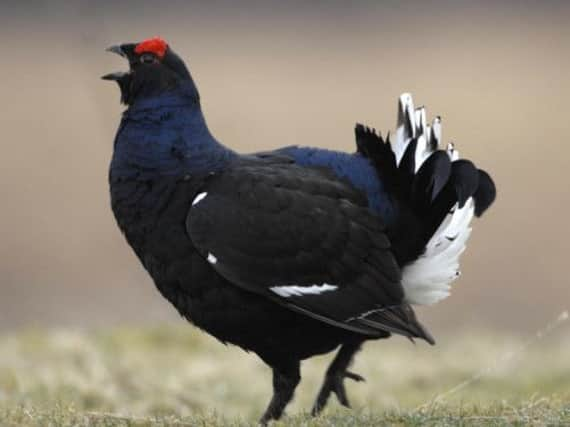Woodland management needed to boost black grouse


The study, carried out by the Game and Wildlife Conservation Trust, n behalf of Scottish Natural Heritage, Cairngorms National Park Authority and Forestry Commission Scotland, used radio-tagging to investigate how individual black grouse use moorland and forests in the mixed highland landscape of north Perthshire.
And it has shown that, while grouse thrive in young forestry plantations, the birds are displaced when the forests are mature.
Advertisement
Hide AdAdvertisement
Hide AdTe findings will be used to help protect black grouse numbers at forestry expansion in Scotland accelerates, driven by the Scottish Government’s Scottish Forestry Strategy to increase cover from 17 to 25 per cent.
The Cairngorms Nature Action Plan also aims to target 5,000 hectares of new woodland by 2018 within the Cairngorms National Park, where a significant portion of the Scottish black grouse population lives.
A spokeswoman trust explained: “Eighty-nine birds were radio-tagged in Perthshire.The study found that black grouse were highly dependent on moorland areas. The type of forests used differed between males and females and use of large-scale plantations was generally limited to within 600 metres of their external edge. “
Lead project scientist Dr Patrick White said:“Although they thrive in young plantations, when these forests mature and ground vegetation is smothered out, black grouse are displaced.
“There is a trade-off between planting forests and protecting these key moorland components that retain breeding habitat over the long-term. Spreading the provision of new forest over time and protecting substantial moorland areas could be important. If planned poorly, significant expansion of commercial forestry onto moorland areas could be detrimental to this species.”
According top the study, where moorland areas are protected, the long-term benefits of any new forests to black grouse may depend on the species they contain and their layout.
“In our study, males selected birch woodland while females avoided these areas and made greater use of conifer forests,” said Dr White.
“Forest expansion will be a key driver in landscape change in Scotland in the next few decades. If we are going to effectively conserve the black grouse we need to make careful decisions about the placement, composition and structure of the new forests we create.”
Advertisement
Hide AdAdvertisement
Hide AdDr Sue Haysom, Policy and Advice Officer for SNH, said: “We were delighted to support this study which has produced three simple management recommendations for black grouse. They are to conserve large and well-connected areas of moorland adjacent to forests; provide a diverse forest age and species composition at the scale of a lekking* group; and constructively manage forest edges on moorland boundaries to enable access.”
Justin Prigmore, Nature Officer at Cairngorms National Park Authority said: “We have recently helped establish Cairngorms Nature, a new partnership set up to safeguard and enhance the outstanding nature in the Cairngorms National Park. By working together with a wide range of partners, it is more likely that this initiative will achieve success and achieve positive change for the biodiversity of the Park. One of the main focuses of the partnership over the coming years will be woodland expansion. This research on the habitat use of black grouse has been extremely important in helping our understanding of how they use their environment. Longer term it will ensure that the needs of the species are taken into account when these new planting schemes are being planned.”
Kenny Kortland, FCS Species Ecologist, also welcomed the study. He said: ‘’The many hours of field work done by GWCT staff have yielded much information on the behaviour of this wonderful species in the Scottish uplands. These findings will allow Forestry Commission Scotland to carry out more cost-effective action for black grouse.’’